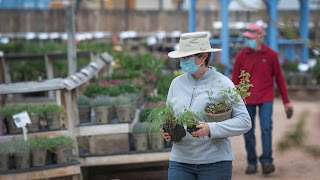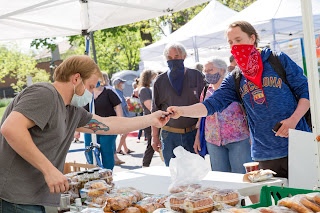Posted by: Alison O'Connor, Larimer County Extension
I feel like yelling, "We made it!" since 2020 is coming to a close and the holidays are (mostly) over. As I type this, I'm glancing around at the remnants of Christmas...leftover cookies, stray gifts, and drooping poinsettias. While we don't have a real Christmas tree (finding needles into June drove me crazy), about 20% of you do. And while many towns and cities offer Christmas tree recycling, there are some other things you can consider doing with your tannenbaum...
Cut it up!
Remove the branches and use them around your landscape. Branches can be used to line sidewalks as a special touch. They can be placed around fall-planted perennials and shrubs for added protection (and to capture snow). You can also let the wood dry and use the tree for firewood in a few months.
 |
| Using Christmas tree branches as mulch for young plants (photo courtesy of Garden Gate Magazine) |
Entertain the birds!
Placing branches on the ground will provide habitat and protection to ground-nesting birds. Standing your whole (undecorated) tree in the backyard can provide shelter to smaller birds who frequent your landscape. I have a very large (and slightly invasive) silver lace vine that encompasses the corner of my fence. Do you know how many birds live in the vine!? Hundreds! Maple the beagle loves to see them fly as she runs, full speed, towards it multiple times per day. I bet the chickens would enjoy the evergreen branches too...something new to peck and investigate.
 |
| A large silver lace vine that has eaten the fence. It's wonderful habitat for small birds. Using this idea, place your Christmas tree in the landscape to provide additional shelter. |
Control your soil!
Cut branches placed on top of your vegetable garden beds will help prevent soil erosion during windy winter days. If you have placed mulched leaves or grass on top of your beds, the branches will help keep those in place.
Make your own plant tags!
This takes a bit more work, but consider cutting up the tree to create flat wooden plant markers. You can then use these in seed starting flats, marking spring-planted bulbs, or even vegetables in your garden.
Create a fort!
The Town of Windsor created an incredible fort last year with recycled Christmas trees called the "Magical Forest". Staff positioned trees to make tunnels and hiding spaces for kids to play. Keeping in mind social distancing requirements, maybe you can create a smaller version in your backyard?
 |
| Windsor's "Magical Forest" (photo courtesy of the Town of Windsor) |
Get your mulch on!
Once you bring your tree to recycle, it's often chipped into mulch. Many towns and cities offer residents the free mulch in the spring. This mulch is as good as any! Plus it might have some fun flecks of color from leftover tinsel that made it through the chipper. If you're not digging the look, then top it off with some colored mulch of your choice. Check with your local authorities to find out when and where Christmas tree recycling is taking place. Please don't send your tree to the landfill, as there are so many other great options.
 |
| Christmas trees are often chipped into mulch, which is often available for free to the public. Check with your local municipality for information. |
Did I miss a great idea? If so, let me know in the comments. Happy New Year to all!









































